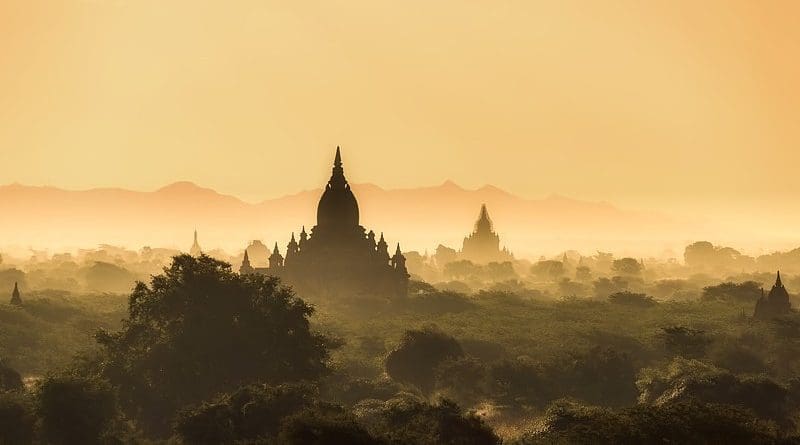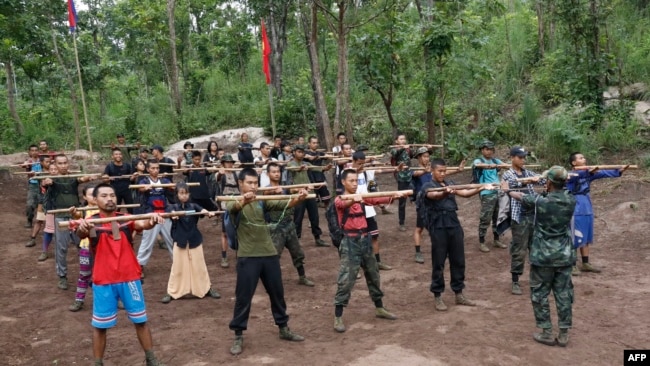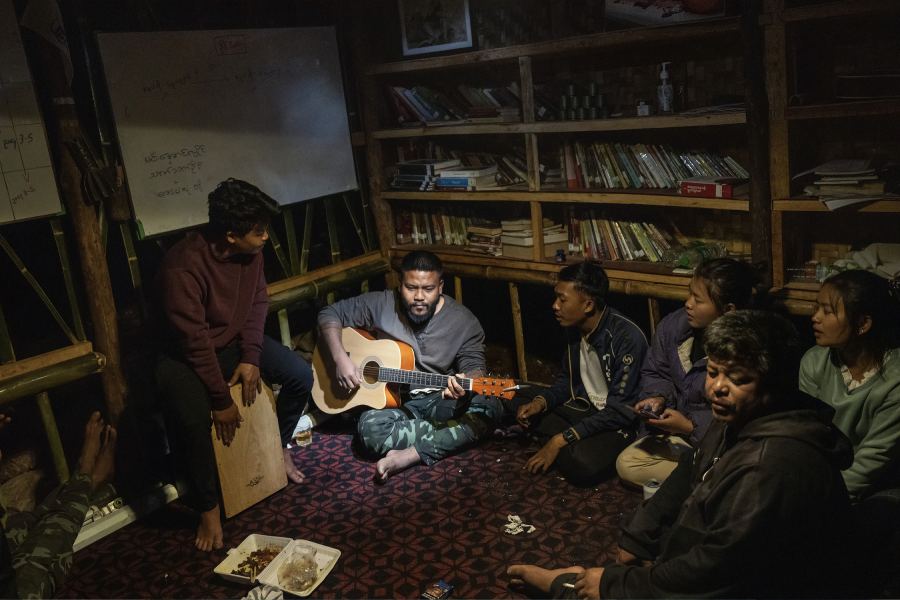
Myanmar’s Economy Is Still In Free Fall – Analysis
By Zachary Abuza
While the Myanmar military regime’s battlefield losses throughout the country are grabbing headlines, the country’s dire economic crisis is further undercutting the junta’s capacity to wage war.
Myanmar’s military has suffered significant battlefield losses throughout the country since an ethnic rebel army alliance launched Operation 1027 nearly six months ago, raising questions whether the military is able to retake lost territories.
Fighting across eight distinct battle scapes, the military is unable to divide and conquer, and even its emphasis on first retaking the heartland of the ethnic majority Bamars, has faltered. In Sagaing, the junta has suffered significant setbacks and only recaptured one town. in southern Myanmar, two Mon resistance organizations agreed to work together as they prepare to go on the attack against the regime.
The junta offensive to recapture Myawaddy, the largest border crossing with Thailand is another case in point. Despite the city’s strategic importance, the military’s counter-offensive has stalled, with their force being reportedly ambushed and harassed.
While manpower issues have led to forced conscription, no less important is whether the regime is able to financially sustain its military operations.
Myanmar is broke, because the junta has broken the economy since its February 2021 coup.
The junta has eviscerated over a decade’s worth of economic growth. Between 2011 and 2019, Myanmar’s economy grew by an average 6% a year, making it one of the fastest growing economies in the region. Its poverty rate fell from 49% in 2005 to 25% in 2017.
While the economy has recovered from its 2021 nadir, when GDP contracted by 18%, it’s still down 12% since the coup. The World Bank’s cautious scenario for 1% growth in 2024 seems beyond reach.
Back into poverty
The military has dragged the country back into poverty through their own incompetence. Today, over 50 percent of the population of 55 million people has fallen back into poverty.
A recent United Nations Development Program report was more dire, citing field interviews that found 49.7% of respondents living on less than 76 U.S. cents a day. That number has doubled since 2017. The UNDP noted that the urban middle class has collapsed by 50% since the coup.
Inflation remains extremely high, at over 18 percent; though it reached 29% in mid-2023, according to the World Bank. Food prices have gone up threefold since the coup, with rice up from 60,000 kyat per kilogram to 180,000.
Firms, according to a World Bank survey, were operating at 56% capacity in 2023, down by 16% from 2022. That has diminished tax receipts.
Indeed, all sources of revenue, except natural gas rents, are down since the coup, according to the regime’s own data. This has been in part due to the economic conditions as well as the NUG’s active campaign of product boycotts, the establishment of alternate lotteries, and a drive to have corporations put their taxes into escrow.
Once cash cows, the two military-owned conglomerates Myanma Economic Holdings Ltd. and Myanma Economic Corporation are hemorrhaging funds. The former has since the coup failed to pay dividends to service members who are forced to invest a portion of their monthly salary.
Foreign investment, other than that from opportunistic Chinese and Thai businesses, is fleeing the country.
The once-thriving digital payments market is under intense military scrutiny, as they seek to control the flow of funds to the opposition.
Border crossings lost
The regime’s shortage of dollars has led to arbitrary currency controls, impacting importers and exporters. The kyat lost 16% of its value in the first quarter of 2024 alone, while the price of gold increased 22%.
The war has hurt the economy in another way. Myanmar-Now reportsthat the State Administrative Council (SAC), as the junta is formally known, only controls 11 border crossings, which has led to a sharp loss of customs duties.
The Kachin Independence Army has captured the Lweje crossing in Kachin State, leaving only the modest town of Kanpaiktee under junta control.
The Myanmar National Democratic Alliance Army holds Chinshwehaw in Shan State, where the Chinese brokered an 80-20 revenue sharing agreement between them and the junta.
Although the SAC still holds Muse, the main border crossing with China, the Three Brotherhood Alliance has surrounded the town and controls the roads to Lashio and has begun collecting taxes.
The junta still controls Tachileik in southern Shan State, as well as a number of smaller crossings in Mon and Tanintharyi States.
In western Myanmar, the Arakan Army’s consolidation of power in northern Rakhine and opposition advances in Chin state mean that the junta has lost control of several of the border crossings to India and Bangladesh.
The loss of the Myawaddy, which has a population of 200,000, is an acute financial blow to the regime. With two bridges into Thailand’s Mae Sot, it was the largest border crossing in the country, accounting for $4.4 billion in trade since the February 2021 coup d’etat, roughly 23% of the country’s total trade.
Reuters noted a sharp decline in trade, especially exports, from April 2023 to March 2024. Bilateral trade fell by over 40 percent to $1.15 billion.
Hyperinflation threat
While junta officials are still manning the border gates, the Karen National Union and local border guards forces are in control of much of the city, and have pledged to “implement our plan to establish our administration one step at a time,” including customs.
The loss of border trade is so deleterious to the regime as their shortage of dollars – exacerbated by the U.S.-imposed sanctions on the Myanma Foreign Trade Bank and the Myanma Investment and Commerce Bank, which handled Myanmar’s dollar transactions – has forced them to prioritize trade in local currencies.
The SAC has desperately stepped up economic cooperation with any willing partners. On April 9, the government met with a Russian-led trading bloc to discuss economic cooperation, including trade, investment, direct payments and the opening of direct flights between Moscow and Yangon. Turning to the Eurasian Economic Commission is a sign of how few choices the regime has.
What is not certain right now is the degree to which the illicit economy from areas controlled by pro-junta border guards forces is ebbing. Seeking to distance himself from Naypyitaw, Col. Saw Chit Thu recently rebranded his border forces as the Karen National Army.
There is intense fighting now outside of Shwe Kokko, one of the major scam centers along the Thai border, though opposition forces have not taken the enclave.
While the MNDAA has largely cooperated with the Chinese and helped return hundreds of Chinese fugitives, many of the scam centers along the Thai border – including KK Park I and II, as well as Family Park, Gate 25, Huanya, Xingua and Dongmei – remain open.
The regime has scapegoated a number of senior-level economic officials, including its seventh-highest official, Lt. Gen. Moe Myint Tun, and his aide. But that’s all they were, scapegoats, no different than the other corrupt and incompetent generals who remain.
Thus far, and defying predictions, the junta has not resorted to turning on the printing press at their banknote facility in Wazi. But as they become more cash strapped, they are likely to do just that.
On top of all the human death and misery the generals have caused in the conduct of a war that has largely targeted civilians, the threat of hyperinflation looms.
Zachary Abuza is a professor at the National War College in Washington and an adjunct at Georgetown University. The views expressed here are his own and do not reflect the position of the U.S. Department of Defense, the National War College, Georgetown University or Radio Free Asia.

RFA
Radio Free Asia’s mission is to provide accurate and timely news and information to Asian countries whose governments prohibit access to a free press. Content used with the permission of Radio Free Asia, 2025 M St. NW, Suite 300, Washington DC 20036.
Myanmar junta slams US aid plan
April 28, 2024 3:06 PMBy Ingyin Naing
 F
FWASHINGTON —
Myanmar’s ruling junta, the State Administrative Council, is criticizing a U.S. aid package that is being funneled through opponents of the regime, saying the United States should consider whether its actions amount to support for terrorism.
The assistance marks the first implementation of the BURMA Act, part of the 2023 National Defense Authorization Act aimed at helping pro-democracy forces battling the SAC.
Under the act, the aid is intended to strengthen federalism in Myanmar by providing nonlethal assistance to armed groups, helping pro-democracy organizations, assisting aid organizations operating from Thailand, and financing investigations of junta human rights violations. The aid is restricted to ensure it does not benefit the SAC or any entity affiliated with the Myanmar military.
“We believe the U.S. is manipulating Myanmar to counter China's influence in the region,” the junta said in a statement provided to VOA on March 29. “Despite the U.S. presenting itself as a champion of democracy, the aid disproportionately benefits Myanmar's opposition groups, particularly the National Unity Government (NUG) and the People's Defense Force (PDF).”
The NUG is the opposition’s shadow government; the PDF is made up of civilian armed groups battling the military.

The junta statement calls on the United States to review its aid allocation “to reassess whether their actions, which some label as terrorism, represent a legitimate path to reclaiming power.”
The junta, which has killed and imprisoned thousands of people since overthrowing the democratically elected government in February 2021, accuses the NUG and PDF of responsibility for the civilian deaths. The statement did not elaborate on the charge that U.S. support for resistance groups in Myanmar is linked to Myanmar’s adversarial relationship with China.
The promise of the BURMA Act
The Burma Unified Through Rigorous Military Accountability Act, commonly called the BURMA Act, says it aims to “continue to support the people of Burma in their struggle for democracy, human rights, and justice.”
It identifies specific resistance groups as beneficiaries, including the NUG, and the National Unity Consultative Council, or NUCC, which comprises several opposition groups.
Also named are the Committee Representing Pyidaungsu Hluttaw, which is made up of members of the ousted Myanmar parliament; the civil disobedience movement; "and other entities in Burma and in other countries” that seek to “bring about an end to the military junta’s rule.”
The act promises to “hold accountable perpetrators of human rights violations,” and to “hold accountable the Russian Federation and the People’s Republic of China.”
It provides $75 million for refugee assistance programs, including in Thailand and India, and $25 million for “technical support and non-lethal assistance” to the NUG and PDF. Smaller amounts are earmarked for governance programs, documentation of atrocities, and assistance to political prisoners, Rohingya and deserters from the junta’s military.

The Rohingya, a predominantly Muslim ethnic minority group, have faced persecution and discrimination in Myanmar for decades. In 2017, a military crackdown by the Myanmar army forced hundreds of thousands of Rohingya to flee to neighboring Bangladesh, seeking refuge from the violence and persecution.
The act authorizes appropriations to be allocated annually from fiscal years 2023 through 2027, with $121 million earmarked for FY 2024.
Process of the funding
During debate on the bill, the U.S. House of Representatives initially proposed a more limited $50 million aid package but agreed to the larger sum advocated by the Senate before final passage.
"We are pleased with the $121 million proposed by the Senate, instead of the $50 million proposed by the House. However, we believe this amount is insufficient, and should be closer to $300 million to meet the humanitarian needs on the ground,” said James Shwe, from the Los Angeles Myanmar Movement, which works with Myanmar activists in the United States.
In a Zoom call with VOA, Shwe also criticized what he sees as the high administrative costs of aid distribution.
“Because of the lack of state-to-state cooperation in a case such as Myanmar, where the aid is meant for humanitarian assistance, but not for the ruling power, this leads to several layers of management,” he said.
“The aid is funneled through USAID partners, the biggest of which is the U.N., which has to operate under the rules of the junta. In many cases, the U.N. will in turn deal with [non-governmental organizations]. The NGO then needs to distribute that aid to [civil society organizations] on the ground. This leads to ever-increasing administrative costs and less actual assistance to those in need.”
Shwe said administration costs eat up around 45% of aid funds.
“Only $75 million of the $121 million is allocated for cross-border aid, which we believe will be more effective than channeling funds through the U.N., the largest partner of USAID," Shwe added. But he welcomed the lawmakers’ decision to specifically name the NUG and the NUCC in the act, ensuring that they will play a role in the allocation of the funds.
Hopes for assistance amid U.S. engagement
Hopes for continued humanitarian assistance to Myanmar are on the rise after U.S. State Department Counselor Derek Chollet and USAID Assistant Administrator Michael Schiffer met this month with representatives from the NUG.
“The meeting underscores the ongoing commitment of the United States to engage with Myanmar's NUG leadership and support their endeavors to promote democracy, peace, and stability in the region,” said an April 11 State Department press release.
Chollet also met in late March with ethnic armed organizations allied with the NUG.
"Met today with leaders of Burma’s ‘K3C’ ethnic group alliance on their extraordinary efforts to pursue a federal democracy in Burma,” he wrote on X on March 28. “We discussed steps for the international community to expand assistance to those in need and secure a better future for the people of Burma."
The K3C alliance, comprising the Kachin Independence Organization, Karen National Union, Karenni National Progressive Party, and Chin National Front, is politically aligned with the NUG and collaborates militarily with its armed wing, the People’s Defense Force.
"We briefed them on the political and military situation in our state, as well as the humanitarian situation,” said Aung San Myint, secretary of the Karenni National Progressive Party, who shared details of the meeting with VOA by phone.
“Following our presentation, they assured us of continued collaboration as the U.S. Department of State. ... We have hope for increased humanitarian aid as discussions progress with U.S. officials."
Rebel fighters, who have overrun dozens of Myanmar military bases in recent offensives, cannot contact battle commanders from front-line outposts
Hannah Beech Demoso,

A commander with the Karenni Nationalities Defense Force, an umbrella organization for bands of armed youth, plays guitar and sings with fellow resistance members near Demoso in Karenni State, in eastern Myanmar, Feb. 1, 2024. Even through the Myanmar military junta’s communications blackout, residents of a conflict zone find moments of grace, and occasional connectivity, away from the battlefield.Adam Ferguson/The New York Times
In the night, the mountain air not quite chill enough to still the insects, young people gathered around a glow. The light attracting them was not a phone screen, that electric lure for people almost everywhere, but a bonfire.
From around the blaze, music radiated. Fingers strummed a guitar. Voices layered lyrics about love, democracy and, most of all, revolution. Moths courted the flame, sparking when they veered too close, then swooning to their deaths.
For months now, these hills of Karenni state in eastern Myanmar have been severed from modern communications. The military junta that seized power in a coup three years ago, plunging the country into civil war, has cut off the populations most opposed to its brutal rule. In these resistance strongholds, where people from around the nation have congregated, there is almost no internet, cell service or even electricity.
The return to a premodern age carries awful consequences for people’s lives. When a baby’s fever spikes, there is no way to call a doctor. Rebel fighters, who have overrun dozens of Myanmar military bases in recent offensives, cannot contact battle commanders from front-line outposts. Students cannot attend online classes, which in some places in Myanmar are the only educational option.
News — who survived an airstrike, whose village was burned, whose daughter has fled the country for work abroad — travels at a pedestrian’s pace or, if expensive fuel can be found, by motorcycles bumping along jungle paths.

New housing for displaced people in the hills near Demoso in Karenni State, in eastern Myanmar, Feb. 1, 2024Adam Ferguson/The New York Times
Yet the communications blackout has brought one unexpected benefit. Without the distraction of hand-held devices, people talk to each other, in person, with eye contact. They joke. They sing. They dance. They play the guitar.
Only a war, it seems, can break the engrossing command of a tiny screen.
In what people in Karenni call the BC years — that’s Before Coup — nearly everyone was on Facebook. Then, in the predawn hours of Feb. 1, 2021, the junta pulled the plug on telecommunications. That was the first sign of trouble. By the morning, most of the nation’s elected leadership had been arrested. They remain imprisoned today.
Since the coup, internet and cell services have been restored in most other parts of the country, but Facebook and other social media are banned. In regions where militias have repelled the junta’s forces — like parts of Karenni state (also known as Kayah state) in the east, Rakhine state in the west, and the Sagaing region and Chin state in the northwest — entire townships are still in the dark.
Without online games to play or videos to stream on phones, the shadowed space at night is filled most often by homegrown music.

A house used by young members of the resistance opposed to the military junta that seized power in a coup three years ago that plunged the country into civil war, in the village of Hose Myo Thet in Karenni State in eastern Myanmar, Jan. 28, 2024.
On the front lines, when the thud of artillery recedes for the day, or the hour, resistance soldiers trade AK rifles for guitars. A rebel army commander slaps a beat on a cajón, the Afro-Peruvian instrument. At a hospital, emergency supplies are lined up against a wall made of leaves: bandages, rubber gloves, rubbing alcohol — and a ukulele.
After serving rebel soldiers a meal of spicy noodles with foraged herbs, Emily Oo picked up a guitar resting on the dirt floor of a security outpost captured last year by opposition forces. A few years ago, she was a middle school student in Loikaw, the state capital of Karenni, studying English and TikTok dance moves.
Last year, she and her family fled home as fighting between resistance soldiers and the junta’s forces engulfed her neighborhood. Most people in Karenni are now displaced, living with a few bundles of their most valuable possessions, including, surprisingly often, a guitar.
“History is written with our blood,” she sang. “The heroes who lost their lives in the battle for democracy.”
The lyrics, part of a well-known revolutionary anthem, were written by candlelight in 1988 when Myanmar was consumed by another national uprising against an earlier military dictatorship. After that protest movement was violently crushed, Myanmar seemed to slip further back in time, while most of Asia urbanized and prospered.

A resistance soldier takes advantage of internet connectivity at an outpost in Loikah in Karenni State in eastern Myanmar, Jan. 31, 2024.
A dozen years ago, the junta then ruling Myanmar priced SIM cards at roughly four times the country’s average annual income, preventing all but the richest from connecting with the world.
As political reforms brought in a quasi-civilian administration in 2016, internet access became cheaper. Facebook accounts proliferated. So did online disinformation. Falsehoods about sexual violence fanned the flames of genocide against a Muslim minority.
Today, in Karenni, Myanmar’s smallest state and one of the least developed even before the online blackout, innuendo again stands in for truth. Conspiracy theories multiply. But amid the uncertainty and paranoia, music acts as a salve.
“Every day I heard the sounds of bombs, airplanes and gunshots,” said Hpray Myar, 23, who fled a junta-controlled city and started a music school in the forests of Karenni. “When we hear the sounds of music, our fears go away a little bit.”
When there is the uncommon chance to access the internet, the appeal of getting online can pose its own dangers.
In January, members of the resistance assembled at a secret command post in Loikaw. They were not there for battle strategy but for access to Wi-Fi, courtesy of Starlink, a satellite internet service used in conflict zones worldwide.
The resistance forces binged on Facebook. They hearted photos of newborn babies and images of other rebel recruits posing, young and resolute, in their camouflage uniforms. Some were so absorbed by their online forays that they didn’t notice the whirring nearby, one soldier who was there recalled.
He and others escaped the armed drone dispatched by the junta’s forces. But three people too tethered to the internet did not and were injured in the attack, one seriously.
The New York Times News Service
No comments:
Post a Comment